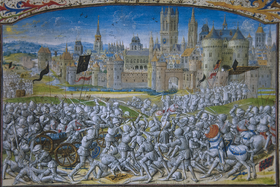Battle of Beverhoutsveld
| Battle of Beverhoutsveld | |||||||
|---|---|---|---|---|---|---|---|
| Part of Ghent rebellion | |||||||
 Battle of Beverhoutsveld in Froissart's Chronicles |
|||||||
|
|||||||
| Belligerents | |||||||
| County of Flanders | Ghent rebels | ||||||
| Commanders and leaders | |||||||
| Louis II of Flanders, Count of Flanders | Philip van Artevelde, leader of the Ghent Rebels | ||||||
| Strength | |||||||
| Greatly outnumbered Ghent force | 4,000-8,000 plus large force of artillery | ||||||
Coordinates: 51°09′22.52″N 3°22′51.91″E / 51.1562556°N 3.3810861°E
The Battle of Beverhoutsveld took place on 3 May 1382, on a field situated between the towns of Beernem, Oostkamp and Assebroek. It marked an important phase in the rebellion of Ghent (led by Philip van Artevelde) against Louis II, Count of Flanders.
The city of Ghent had rebelled against their lord, count Louis II of Flanders, in 1379. The powerful guilds in Ghent did not take kindly to his rule, and wanted more privileges and less interference from the count. The nearby city of Bruges was a loyal supporter of the count and this only served to fan the flames of the rivalry between the two cities, both commercial powerhouses.
The Gent-Oostende canal is one of the oldest shipping routes in Belgium. A natural watercourse between the towns of Bruges and Beernem was adapted for this shipping route. It was this piece of canal that caused the conflict between the Bruges and Ghent people.
To force Ghent to surrender, the Count of Flanders had blockaded the access roads to the city. Philip van Artevelde, the leader of the Ghent rebels, was attempting to negotiate with the Count in Doornik, but these negotiations failed and the only option was to assault the town of Bruges to force access to the sea.
...
Wikipedia
